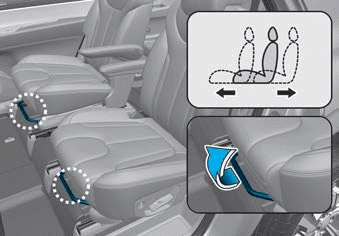Hyundai Palisade: Door locks / Operating Door Locks from Inside the Vehicle
With the door lock button

- To unlock a door, push the door lock button (1) to the "Unlock" position. The red mark (2) on the door lock button will be visible.
- To lock a door, push the door lock button (1) to the "Lock" position. If the door is locked properly, the red mark (2) on the door lock button will not be visible.
- To open a door, pull the door handle (3) outward.
- If the inner door handle of either the driver door or passenger door is pulled when the door lock button is in the lock position, the button is unlocked and the door will open.
- For Key Start Vehicles (with Remote Key) The front doors cannot be locked if the remote key is in the ignition switch and either of the front doors are open.
- For Push Button Start Vehicles (with Smart Key) The doors cannot be locked if the smart key is inside the vehicle and any of the doors are open.
Information
If a power door lock ever fails to function while you are in the vehicle try one or more of the following techniques to exit:
- Operate the door unlock feature repeatedly (both electronic and manual) while simultaneously pulling on the door handle.
- Operate the other door locks and handles, front and rear.
- Lower a front window and use the mechanical key to unlock the door from outside.
Information
When the vehicle’s battery run out and you leave the vehicle, make sure all the doors are locked. You can lock the driver’s door with a key and the rest of the doors with the lock button above the door inside handle.
With the central door lock switch

The driver side and front passenger side door armrest is equipped with a central door lock switch. The lock button is indicated by a ( ) symbol. The unlock button is indicated by a ( ) symbol.
When the lock button (1) is pressed, all the vehicle doors will lock.
When the unlock button (2) is pressed, all the vehicle doors will unlock.
- For Key Start Vehicles (with Remote Key) If the key is in the ignition switch and any door is opened, the doors will not lock even though the lock button (2) is pressed.
- For Push Button Start Vehicles (with Smart Key) If the smart key is in the vehicle and any door is open, the doors will not lock even though the lock button (2) is pressed.
WARNING
- The doors should always be fully closed and locked while the vehicle is in motion. If the doors are unlocked, the risk of being thrown from the vehicle in a crash is increased.
- Do not pull the inner door handle of the driver's or passenger's door while the vehicle is moving.
WARNING
Do not leave children or animals unattended in your vehicle. An enclosed vehicle can become extremely hot, causing death or serious injury to unattended children or animals who cannot escape the vehicle. Children might operate features of the vehicle that could injure them, or they could encounter other harm, possibly from someone gaining entry to the vehicle.
WARNING
Always secure your vehicle.
Leaving your vehicle unlocked increases the potential risk to you or others from someone hiding in your vehicle. To secure your vehicle, while depressing the brake, press the P (Park) button, engage the parking brake, and place the ignition switch in the LOCK/OFF position, close all windows, lock all doors, and always take the key with you.
CAUTION
Opening a door when something is approaching may cause damage or injury. Be careful when opening doors and watch for vehicles, motorcycles, bicycles or pedestrians approaching the vehicle in the path of the door.
WARNING
If you stay in the vehicle for a long time while the weather is very hot or cold, there are risks of injuries or danger to life. Do not lock the vehicle from the outside when someone is in the vehicle.
 Operating Door Locks from
Outside the Vehicle
Operating Door Locks from
Outside the Vehicle
Mechanical key
[A] : Unlock, [B] : Lock
First, pull the outside door handle (1)
and push the hook (2) located inside
of outside door handle by using the
mechanical key...
 Automatic Door Lock and
Unlock Features
Automatic Door Lock and
Unlock Features
Your vehicle is equipped with features
that will automatically lock or
unlock your vehicle based on settings
you select in the cluster LCD
display...
Other information:
Hyundai Palisade (LX2) 2020-2025 Service Manual: Mode Control Actuator
Description and operation Description The mode control actuator is located at the heater unit. It adjusts the position of the mode door by operating the mode control actuator based on the signal of the A/C control unit. Pressing the mode select switch makes the mode control actuator shift in order of Vent → Bi-Level → Floor → Mix...
Hyundai Palisade (LX2) 2020-2025 Owner's Manual: To decrease the Smart Cruise Control set speed
Follow either of these procedures: Push the toggle switch down (SET-), and release it immediately. The cruising speed will decrease by 1 mph (1 km/h) each time you move the toggle switch down in this manner. Push the toggle switch down (SET-), and hold it...
Categories
- Manuals Home
- 1st Generation Palisade Owners Manual
- 1st Generation Palisade Service Manual
- Fuse/Relay Panel Description
- Wireless Cellular Phone Charging System
- Electronic Child Safety Lock System
- New on site
- Most important about car
Rear Seats
Rear seat adjustment

Forward and rearward (2nd row seat)
To move the seat forward or rearward:
1. Pull the seat slide adjustment lever up and hold it.
2. Slide the seat to the position you desire.
